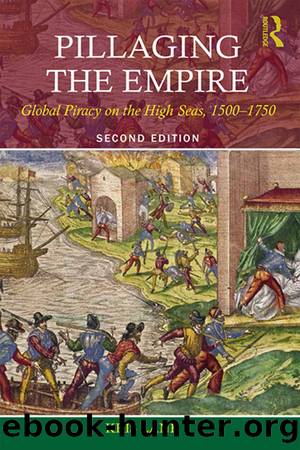Pillaging the Empire by Kris Lane

Author:Kris Lane [Kris Lane]
Language: eng
Format: epub
Publisher: Routledge
Bartholomew Sharp: Pirate Captain of Last Resort
Having experienced a relative calm in the South Sea in the years following the Dutch intrusions of the early 1640s, the Viceroyalty of Peru had allowed its defenses to wither. The fleet assembled to face Hendrick Brouwer’s supposed returnees was considered largely unnecessary following the Dutch peace in 1648, and Valdivia reverted to its earlier function as a fortress against rebellious Mapuches. In spite of faltering silver production, the third quarter of the seventeenth century was a time of relative economic expansion in the Pacific region and this shift was evident in the growing tonnage of shipping, much of it illegal, linking Peru with New Spain.4 Intercolonial commercial shipping, which carried a wide variety of bulk goods, including wines, fruits, flour, timber, cheap cloth, indigo, cacao, and so on, boomed as local defense spending declined. The much resented donativos and situados (what might be called “pirate-war taxes”) were still present, and highlanders from Santafé de Bogotá to Santiago de Chile paid dearly in the form of these imposts to defend the more vulnerable Caribbean ports of Portobelo, Cartagena, and Santa Marta. In the meantime the Pacific squadron, or Armada del Mar del Sur, fell into disuse, its ships and crews proving more expensive to maintain than they were worth. Likewise, port fortifications from California to Tierra del Fuego fell to ruins. No attempt had been made to keep up the walls around Callao, for example, since their construction during the decades-past Dutch threat. Substantial debts to contractors were still outstanding in Lima in 1656, and between the action of the waves and inaction of the authorities, the walls of Callao were full of breaches by the 1670s.5 Officials all along the west coast knew their defenses were weak, and thus responded with panic when rumors such as those started by the mysterious don Carlos hinted at international intrigue and pending invasions.
Though Spanish officials in Lima thought these international conspiracies were in some way linked to the buccaneers, Bartholomew Sharp and his compatriots entered the South Sea in April of 1680 in total ignorance. The buccaneers were split into a half-dozen factions, under as many captains (none apparently with any experience in the Pacific) and their actions reflect disagreement and disarray rather than rational organization and clear objectives. Oddly, however, it was this very unpredictability, the fluid dynamic, as it were, of the first South Sea “pirate cycle,” that kept the Spanish off guard. Since it was clear that not even the pirates knew where they were going, how could the Spanish know? Throwing caution to the wind, this mostly English-born, self-described “pack of merry boys” set out across the Darien wilds with one common objective: South Sea booty. To put it bluntly, the pirates were driven, according to one participant, by nothing more than “the sacred hunger of gold.”6
Sharp and the buccaneers had left Golden Isle—which had no gold, it seems—on the northeast coast of Panama (or Darien) on 5 April 1680, and arrived in the Gulf of San Miguel around 20 April.
Download
This site does not store any files on its server. We only index and link to content provided by other sites. Please contact the content providers to delete copyright contents if any and email us, we'll remove relevant links or contents immediately.
| Automotive | Aviation |
| History | Mass Transit |
| Owner's Manuals & Maintenance Guides | Railroads |
| Reference | Ships |
Small Unmanned Fixed-wing Aircraft Design by Andrew J. Keane Andras Sobester James P. Scanlan & András Sóbester & James P. Scanlan(32151)
Navigation and Map Reading by K Andrew(4563)
Endurance: Shackleton's Incredible Voyage by Alfred Lansing(3859)
Wild Ride by Adam Lashinsky(1662)
And the Band Played On by Randy Shilts(1626)
The Box by Marc Levinson(1604)
Top 10 Prague (EYEWITNESS TOP 10 TRAVEL GUIDES) by DK(1572)
The Race for Hitler's X-Planes: Britain's 1945 Mission to Capture Secret Luftwaffe Technology by John Christopher(1533)
The One Percenter Encyclopedia by Bill Hayes(1471)
Girls Auto Clinic Glove Box Guide by Patrice Banks(1370)
Trans-Siberian Railway by Lonely Planet(1352)
Looking for a Ship by John McPhee(1325)
Batavia's Graveyard by Mike Dash(1307)
Fighting Hitler's Jets: The Extraordinary Story of the American Airmen Who Beat the Luftwaffe and Defeated Nazi Germany by Robert F. Dorr(1306)
Troubleshooting and Repair of Diesel Engines by Paul Dempsey(1289)
Bligh by Rob Mundle(1279)
TWA 800 by Jack Cashill(1257)
The Great Halifax Explosion by John U. Bacon(1234)
Ticket to Ride by Tom Chesshyre(1233)
